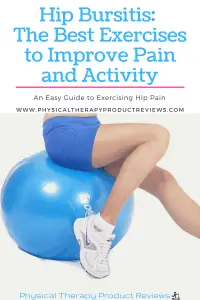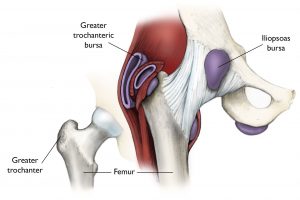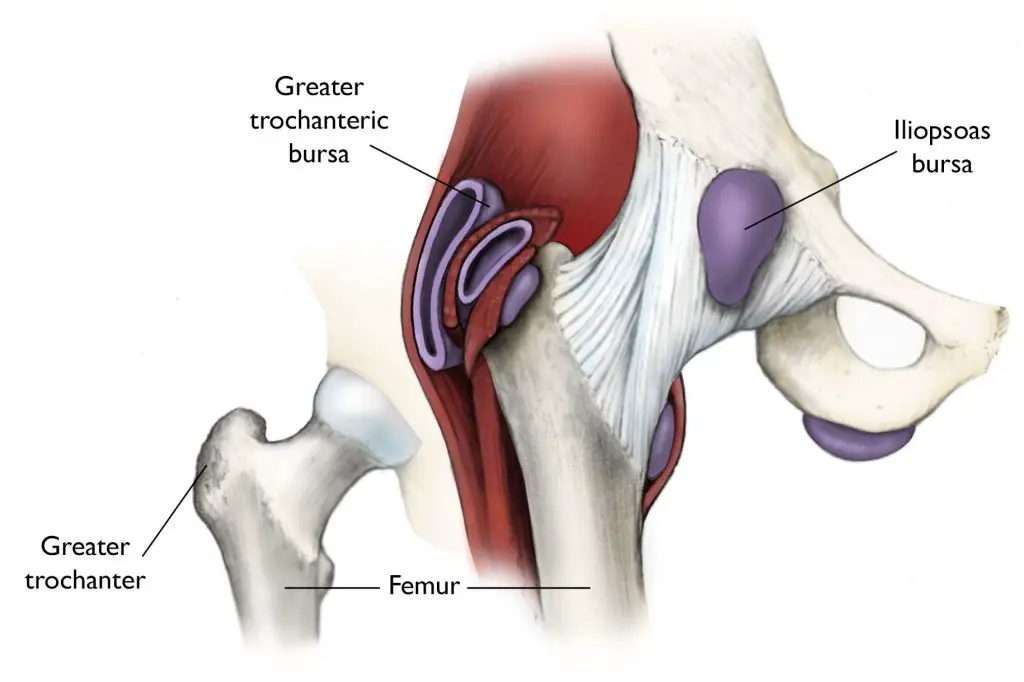Greater Trochanter Pain Syndrome
 One of the most common causes of hip pain is what is commonly called hip bursitis or what is now calle Greater Trochanteric Pain Syndrome. This painful overuse hip condition causes pain and inflammation near the joints and surrounding soft tissue of the hip. Hip bursitis is quite common among multiple populations and can cause limitations to daily activities, reduce overall activity, and decrease your quality of life. We use our hips constantly during our daily lives when we walk, stand, sit, lift, and or move throughout our day. Pain and limitation can be frustrating obstacles to these everyday movements.
One of the most common causes of hip pain is what is commonly called hip bursitis or what is now calle Greater Trochanteric Pain Syndrome. This painful overuse hip condition causes pain and inflammation near the joints and surrounding soft tissue of the hip. Hip bursitis is quite common among multiple populations and can cause limitations to daily activities, reduce overall activity, and decrease your quality of life. We use our hips constantly during our daily lives when we walk, stand, sit, lift, and or move throughout our day. Pain and limitation can be frustrating obstacles to these everyday movements.
What is Hip Bursitis?
Hip bursitis is a medical condition that causes pain in the bursa and the surrounding tendons on the outside of the hip joint. Bursa are small fluid-filled sacs located throughout the body that cushion our joints and reduce friction when we move. They can also acts lubricants and cushions between tendons. Hip bursitis occurs when the bursa around our hip joints become inflamed and irritated. This often happens when our muscles on the outside of the hip, particularly the Gluteus Medius and Gluteus Minimus, are not strong enough to support our daily activities. The weakness causes more stress in the tendons and if it becomes too much stress too often, it will cause micro-tears in the tendon. These micro tears cause tendon thickening, inflammation and less elasticity, all of which can irritate the bursa. The most common form of hip bursitis presents in the outer hip area and is known as Trochanteric Bursitis.

Causes of Hip Bursitis
There are several factors that can have an effect on the joints in our hips. The most common explanation cause for most peopls is
“doing too much, after doing too little for a long period time.”
This cause of hip bursitis is overuse through regularly repeated activities during work or play. Repeating the same strenuous activities over a long period of time can result in strain and repetitive stress to the bursa. This process does not happen overnight and often takes weeks or months to develop unbeknownst to the patient.
Another less common cause is direct trauma on the outside of hip such as hitting into objects, falling, or anything that places excessive strain on the hip. This direct blow to the area creates inflammation and weakness in the hip muscles, setting it up for potential bursitis.
Symptoms/Indicators of Hip Bursitis
Certain activities can worsen hip bursitis, causing pain and inflammation to increase. Common signs of GTPS are pain with positions like lying on one side or standing on one leg for an extended period of time often cause pain to worsen. Another common sign of hip bursitis is a pain when walking upstairs. The most common symptoms associated with hip bursitis are:
- Sharp pain in the outer hip
- Aching pain that radiates from the hip to the thigh or buttock
- Hip pain that worsens at night
- Sudden hip pain that occurs when standing up after sitting
- Pain with palpation or pressure directly over the outside of the hip
How to Avoid Hip Bursitis
This is one of the most common questions that we get as therapists. The simpliest answer is to continue moving and exercising. Exercising a mininum of 2-3x a week can help prevent tendonitis and other complications of the hip. Strength training and exercises that focus on the hip are the single leg best way to prevent bursitis, especially in females. Some of the exercises included are also great preventative exercises.
Frequently Asked Questions:
How Long Does Hip Bursitis Last?
The time of recovery for hip bursitis varies by how severe the Bursitis is. It can resolve on its own within a couple of weeks or it can become chronic and persists for 6-9 months if left untreated. Even in cases where it seems to resolve on its own, it’s not uncommon for it to periodically return from time to time as it hasn’t truly fully healed.
Should I get an Injection for Hip Bursitis?
A Cortisone Injection is usually one of the last resorts in regards to hip bursitis. It has been shown to effective in regards to hip bursitis to help with pain and inflammation. This can help decrease the pain and improve function in the short term. There are a couple of problems with Cortisone injections in that Cortisone steroids can degrade tendon and other soft tissue. Repetitive steroid injections are a risk factor for other complications within tendons. Also, steroids sometimes just mask the issue. If the muscles and tendons aren’t strong enough to support the body then the steroid injections will only hide that weakness until the shot wears off.
What’s the Best Position to Sleep with Hip Bursitis?
One of the most common complaints of hip bursitis is pain and difficulties with sleeping. This is painful when lying on both the involved and the uninvolved side but for different reasons. When lying on the painful side the pressure from the mattress and the bodyweight compresses the hip. When lying on the non-injured side, the hip is stretched as it rests on the other leg. Therefore, other than sleeping on your back, we recommend sleeping on the non-injured side but using a knee pillow to keep the hips in a straight line and reduce the tension on the tendon.
Why Do Stairs Hurt So Much with Hip Bursitis?
Stairs are one of the most common activities that people first notice to be painful with bursitis. Stairs aggravate bursitis because it is essentially a single leg step up over and over again. Coming down stairs is often worse and more painful. Going stairs is a single leg squat over and over again. In that position the hip has to control not only the decent of the body but also the rotation and the stability of the leg. The hip tendons are being pulled in two different directions at ones and this can irritate the bursa.
The Best Exercises and Stretches for Hip Bursitis
Although hip bursitis can be a frustrating and painful condition, there are plenty of helpful exercises that work to alleviate pain and increase flexibility and strength in the hip area.
Standing Hip Abduction
The first exercise is the standing hip abduction. This exercise is performed standing near a sturdy surface that you can hold onto for support. The movement involves balancing yourself on one leg as you straighten the other leg and lift it out to the side. Try not to put the moving leg back on the ground and maintain a single leg balance. This motion is repeated several times, alternating between each leg. This works to strengthen your hip and leg muscles to provide better support for your hips and pelvis, relieving pressure on the hip bursae. It also improves your ability to shift your weight correctly, which helps you to have better control when you’re walking adn going up or down stairs. We also recommend doing it with a resistance band around the ankles to get more benefit. We like the Perform Better Resistance bands due to their resistance and durability. One important key: The leg that is getting most of the work is the stance leg! Not the leg that is actually moving.
Single-Leg Dead Lift
Another balance-based exercise is the single-leg deadlift. This exercise is performed standing, using bodyweight to control and improve balance. The movement involves standing with one leg planted firmly on the ground and slightly bent while the other is lifted straight back slowly, using the hips like a hinge and keeping the body balanced. As your leg moves upwards behind you, your abdomen will move forward and down. Keep your hands close to your shins, making sure to not pitch your weight forward and offset your balance. You can use dumbbells in your hands to counteract the weight of your leg as you move your torso forward. When using dumbbells, make sure to draw the shoulders back. If not using dumbbells, you can make the movement more challenging by following the leg lift with a single-leg squat. This movement requires you to hold on to something for balance. These exercises involve focused balance training to strengthen key muscles in the glutes and hamstrings, providing additional support for the hips. This is one of the highest Glute Medius activation exercises in recent EMG studies of the Hip.
Bridges with Band Around the Knees
The third exercise is the bridge with a resistance band around the knees. This exercise is performed lying flat on one’s back, knees up and apart, with a resistance band around the knees, making sure the lower back is straight (tilt the pelvis backwards so that your lower spine touches the floor). The movement involves lifting the hips upwards off the ground while squeezing the glutes and pushing the knees outward against the resistance band. This strengthens your glute muscles as well as your hamstrings and core, which in turn provides more support and mobility for hip movements. Again, we recommend using the perform better resistance bands to get the full benefit in the hip muscles.
Side-Lying Clamshells with a Band
Another exercise that uses resistance bands is the side-lying clamshell. This exercise is performed lying on one side, resistance band positioned slightly above the knees, with head supported by the arm or a pillow. The movement involves bending both knees with ankles together, lifting one knee up and apart from the other and coming back down several times. This is then repeated lying on the other side, lifting the other knee up and down. This also works the gluteus medius muscles, helping to support the knees, hips, and back. All three of these areas can take the pressure off of the hips when the muscles are strengthened, which can alleviate symptoms of hip bursitis. This exercise look easy but it will burn if done properly!
Figure-4 Piriformis Stretch
The figure 4 stretch targets the muscles that attach at the top and on the backside of the hip, including the Piriformis and the deep hip rotators. Start by lying on your back on a foam exercise mat (really inexpensive from Amazon). Cross the target leg over the other one so that your legs make the letter “4.” From this point, you can either push the target knee towards the feet or grab the non-involved leg and pull towards you. You should be feeling this stretch in the hip on the same leg that you crossed over. Hold this at least 30 seconds but you can always hold for longer.
Eccentric Lateral Step Down
This exercise is the hardest and most advanced on the entire list. This should only be done once the hip has began to feel better as this can aggravte symptoms more if done too soon. We Do Expect This Exercise To Be Uncomfortable! For more information you can see our in-depth review of this exercise in its effectiveness with helping knee pain. We love this exercise exercise for many reasons but simply put, 1.) it works the hip and thigh muscles hard 1.) it’s easy to do at home 3.) it targets the exact muscles effected in bursitis. Start by standing on top of an aerobic step on the effected leg. Begin by slowly lowering the non-injured leg to the floor and barely tap your heel to the ground. It’s important to not transfer any weight to the leg and just tap. Then slowly pust yourself back up to the starting spot. Try to go until you can’t do anymore or have only a a few reps left.
Supine Glute Medius Stretch
One stretch that is recommended for hip bursitis is the supine gluteus medius stretch. This stretch is performed lying flat on one’s back with one leg outstretched as the other is bent and pushed to the opposite side. The movement involves taking the right hand and placing it on the outer knee of the bent left leg, then slowly pushing the bent leg across the body, stretching over the straightened right leg. The stretch is then repeated on the other side with the other hand and leg and can be performed three times on each side. This works to stretch the surrounding muscles, decreasing stiffness that causes pain in hip bursitis. It also can help to increase the length of one’s stride when walking.
Conclusion:
Living with hip bursitis can be frustrating, and it often feels like something you have little control over. However, stretching and exercising your hips and the surrounding muscle groups can add a lot of movement back into your life, and alleviate some of the pain and symptoms that are associated with hip bursitis. Incorporating these exercises into your daily routine will make a big difference in the everyday symptoms of hip bursitis.
Works Cited:
“Trochanteric Bursitis (Hip Bursitis).” Cleveland Clinic, https://my.clevelandclinic.org/health/diseases/4964-trochanteric-bursitis
“Hip Bursitis – OrthoInfo – AAOS.” OrthoInfo,
https://orthoinfo.aaos.org/en/diseases–conditions/hip-bursitis
https://www.ncbi.nlm.nih.gov/pmc/articles/PMC4761624/pdf/main.pdf
Evidence-Based Soft Tissue Rheumatology: III: Trochanteric Bursitis
Greater Trochanteric Pain Syndrome (Greater Trochanteric Bursitis)
Disclaimer: The information provided in this post is for educational purposes only. This is not a substitute for a medical appointment. Please refer to your physician before starting any exercise program.




